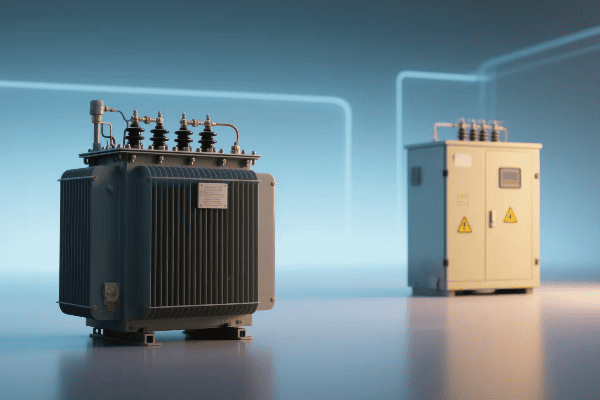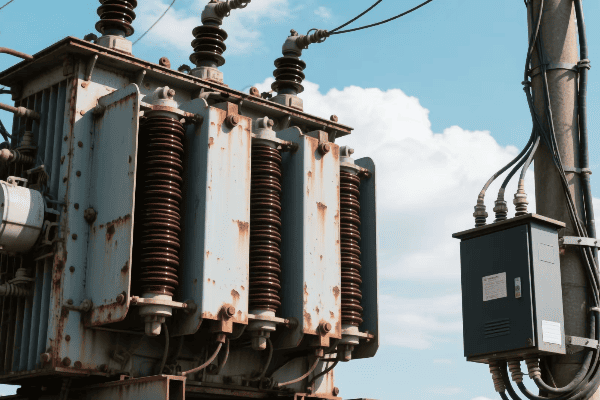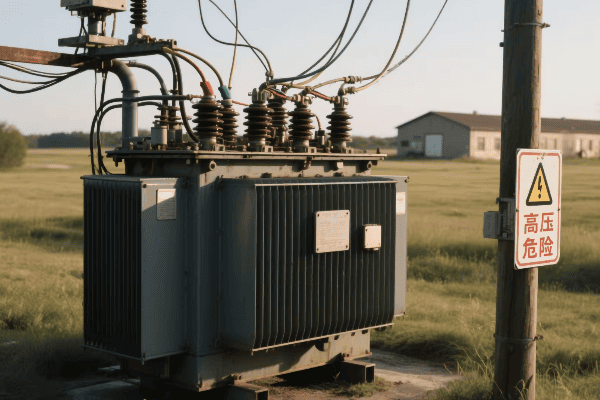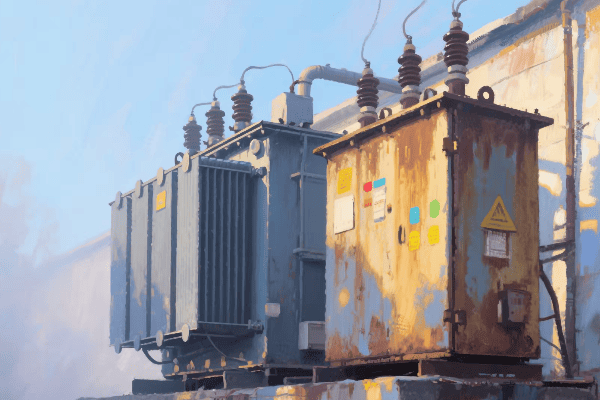Power Transformer and Distribution Transformer: Key Differences in Electrical Grid Applications?
Have you ever wondered why we need different types of transformers in our electrical grid? The answer lies in the unique roles of power and distribution transformers.
Power transformers and distribution transformers serve distinct functions in the electrical grid. Power transformers handle high voltages and large power capacities, typically found in power plants and substations. Distribution transformers operate at lower voltages and are used to supply power directly to consumers.

In this article, I’ll explain the key differences between power and distribution transformers. My experience in designing and working with both types has taught me the crucial distinctions that impact their applications in the electrical grid.
How Do Power Transformers and Distribution Transformers Differ in Their Voltage Handling Capabilities?
When I first started working with transformers, I was amazed by the vast difference in voltage levels they could handle. This difference is fundamental to their roles in the power system.
Power transformers typically handle voltages from 69 kV up to 765 kV or higher, facilitating long-distance power transmission. Distribution transformers, on the other hand, step down voltages to levels suitable for end-users, usually from 4 kV to 34.5 kV on the primary side to 120/240 V on the secondary side.

Let’s dive deeper into the voltage handling capabilities of these transformers:
Power Transformers: High Voltage Champions
Power transformers are designed for high voltage applications. I once worked on a project involving a 500 kV power transformer. The sheer size and complexity of its insulation system were impressive.
- Primary Voltage Range: Typically 69 kV to 765 kV or higher
- Secondary Voltage Range: Often steps down to sub-transmission voltages (e.g., 69 kV to 138 kV)
- Insulation Requirements: Extensive and complex due to high voltages
Distribution Transformers: Bringing Power to Consumers
Distribution transformers operate at much lower voltages. In a recent residential project, we used transformers that stepped down 12.47 kV to 120/240 V for household use.
| Aspect | Primary Side | Secondary Side |
|---|---|---|
| Voltage Range | 4 kV to 34.5 kV | 120/240 V to 480 V |
| Insulation | Less complex | Standard for low voltage |
| BIL (Basic Impulse Level) | Lower than power transformers | Designed for end-user safety |
Voltage Regulation Capabilities
The ability to regulate voltage differs between these transformer types:
- Power Transformers: Often equipped with on-load tap changers for voltage regulation
- Distribution Transformers: Usually have off-load tap changers or no tap changers at all
I remember a case where we had to retrofit a power transformer with an advanced on-load tap changer to improve voltage stability in a growing industrial area.
Impact on System Design
The voltage handling capabilities of these transformers significantly impact overall system design:
- Power Transformers: Key in determining transmission line voltages and substation configurations
- Distribution Transformers: Influence the layout and capacity of local distribution networks
In my experience, understanding these voltage capabilities is crucial for effective power system planning and operation.
What Are the Distinct Roles of Power Transformers and Distribution Transformers in the Electrical Grid?
Understanding the roles of power and distribution transformers is key to grasping how our electrical grid functions. I’ve seen firsthand how these different transformers work together to keep our lights on.
Power transformers play a crucial role in bulk power transmission, facilitating the transfer of large amounts of electricity over long distances. Distribution transformers are the final link in the power delivery chain, stepping down voltage to levels suitable for homes and businesses.

Let’s explore the distinct roles of these transformers:
Power Transformers: The Backbone of Transmission
Power transformers are vital in the transmission network. I once worked on upgrading a substation where the power transformer was the centerpiece of the entire operation.
- Step-Up Transformation: At power plants, increasing generator voltage for efficient transmission
- Bulk Power Transfer: Enabling the movement of large amounts of power across the grid
- Interconnection: Facilitating power exchange between different regions or countries
Distribution Transformers: Bringing Power to the People
Distribution transformers are the unsung heroes of our local power supply. In a recent urban development project, I saw how crucial these transformers were in powering an entire neighborhood.
| Function | Power Transformer | Distribution Transformer |
|---|---|---|
| Location | Power plants, Substations | Neighborhoods, Poles, Pad-mounted |
| Power Capacity | Typically > 10 MVA | Usually < 5 MVA |
| End Users | Other substations, Large industries | Homes, Small businesses |
System Stability and Reliability
Both types of transformers contribute to system stability, but in different ways:
- Power Transformers: Crucial for overall grid stability and power flow control
- Distribution Transformers: Essential for local voltage regulation and power quality
I recall a project where we had to carefully coordinate the protection settings of power and distribution transformers to ensure seamless operation during fault conditions.
Energy Loss Considerations
The role of these transformers in managing energy losses is significant:
- Power Transformers: Focus on minimizing losses for large-scale efficiency
- Distribution Transformers: Balancing efficiency with cost for widespread deployment
In my experience, even small improvements in distribution transformer efficiency can lead to significant energy savings across the grid.
Future Grid Integration
As our grid evolves, so do the roles of these transformers:
- Power Transformers: Adapting to integrate large-scale renewable energy sources
- Distribution Transformers: Evolving to handle bi-directional power flow in smart grids
I’m currently involved in a project exploring how distribution transformers can better accommodate distributed energy resources like rooftop solar panels.
How Do Design and Construction Features Vary Between Power and Distribution Transformers?
The design and construction of power and distribution transformers reflect their distinct roles and operating conditions. I’ve had the opportunity to work on both types, and the differences are fascinating.
Power transformers are typically larger, custom-designed units with advanced cooling systems and robust mechanical structures to handle high voltages and power levels. Distribution transformers are smaller, often standardized units designed for cost-effective production and easier installation in various locations.

Let’s explore the key design and construction differences:
Core and Winding Design
The core and winding designs vary significantly:
-
Power Transformers:
- Often use shell-type cores for better mechanical strength
- Complex winding arrangements to handle high currents
- Advanced insulation systems for high voltage stress
-
Distribution Transformers:
- Typically use simpler core-type designs
- More standardized winding arrangements
- Insulation designed for lower voltage applications
I once worked on a power transformer design that used a novel core material to reduce losses. The complexity of integrating this material into the large core structure was a significant engineering challenge.
Cooling Systems
Cooling system design is a critical difference:
| Aspect | Power Transformer | Distribution Transformer |
|---|---|---|
| Cooling Methods | ONAN, ONAF, OFAF, ODAF | Mainly ONAN |
| Oil Volume | Large oil volumes | Smaller oil volumes or dry-type |
| Radiators | Often extensive radiator banks | Simple radiators or tanks |
In a recent project, we had to design a custom cooling system for a large power transformer located in an extremely hot climate. The solution involved a combination of forced oil and forced air cooling (OFAF) with additional heat exchangers.
Tap Changers
Tap changer designs differ significantly:
-
Power Transformers:
- Often equipped with on-load tap changers (OLTC)
- Complex mechanisms for voltage regulation under load
- Wide range of tap positions
-
Distribution Transformers:
- Usually have off-load tap changers or no tap changers
- Simpler designs with fewer tap positions
- Manual adjustment when de-energized
I remember a challenging project where we had to retrofit an OLTC onto an existing power transformer to improve voltage regulation in a rapidly growing industrial area.
Bushings and Terminals
The design of bushings and terminals also varies:
-
Power Transformers:
- Large, complex bushings for high voltage insulation
- Often oil-filled or SF6 gas-filled bushings
- Robust terminal designs for high current capacity
-
Distribution Transformers:
- Simpler, smaller bushings
- Often solid or polymer-type insulators
- Standardized terminal configurations for easy connection
In my experience, the design of power transformer bushings can be as complex as the transformer itself, especially for ultra-high voltage applications.
Monitoring and Protection
The level of monitoring and protection differs:
-
Power Transformers:
- Extensive monitoring systems (temperature, gas, partial discharge)
- Complex protection schemes
- Often include online monitoring and diagnostics
-
Distribution Transformers:
- Basic overload and short-circuit protection
- Simple temperature monitoring
- Generally rely on external protection devices
I’ve been involved in implementing advanced monitoring systems for power transformers that can predict potential failures weeks in advance, significantly improving reliability and maintenance planning.
What Are the Efficiency and Loss Considerations for Power Transformers vs. Distribution Transformers?
Efficiency and loss considerations are crucial in transformer design and operation. I’ve spent a significant part of my career optimizing these aspects for both power and distribution transformers.
Power transformers typically have higher efficiency ratings due to their larger size and the critical nature of their role in the grid. Distribution transformers, while also designed for efficiency, must balance performance with cost-effectiveness for widespread deployment. Both types focus on minimizing core and winding losses, but the approaches differ.

Let’s delve into the efficiency and loss considerations for both types:
Types of Losses
Both transformer types experience two main types of losses:
-
No-Load Losses (Core Losses):
- Occur whenever the transformer is energized
- Caused by the magnetization and demagnetization of the core
-
Load Losses (Copper Losses):
- Vary with the load on the transformer
- Caused by resistance in the windings
In my experience, balancing these losses is a key challenge in transformer design.
Efficiency Ratings
Efficiency ratings differ between the two types:
| Aspect | Power Transformer | Distribution Transformer |
|---|---|---|
| Typical Efficiency | 99.5% – 99.9% | 98% – 99% |
| Rated Load | Often designed for optimal efficiency at 50-70% load | Typically optimized for 35-50% load |
| Efficiency Standards | IEC 60076-20, IEEE C57.12.00 | DOE 10 CFR Part 431, EU Ecodesign |
I once worked on a project to upgrade a substation’s power transformers. By choosing high-efficiency units, we were able to reduce energy losses by over 20%, resulting in significant cost savings for the utility.
Core Material and Design
The choice of core material significantly impacts efficiency:
-
Power Transformers:
- Often use higher grade silicon steel or amorphous metals
- Complex core designs to minimize flux path length
- Larger core cross-sections to reduce flux density
-
Distribution Transformers:
- Balancing cost and performance with silicon steel grades
- Simpler core designs for ease of manufacturing
- Optimized core sizes for standard ratings
In a recent distribution transformer design project, we experimented with different core materials to find the optimal balance between efficiency and cost.
Winding Design and Materials
Winding design also plays a crucial role in efficiency:
-
Power Transformers:
- Often use continuously transposed conductors (CTC) to reduce eddy current losses
- Complex winding geometries to optimize current distribution
- Sometimes use exotic materials like superconductors for ultra-high efficiency
-
Distribution Transformers:
- Simpler winding designs for cost-effective production
- Focus on optimizing conductor sizes and arrangements
- Sometimes use aluminum instead of copper for cost savings
I’ve been involved in projects where we used advanced simulation tools to optimize winding designs, resulting in significant reductions in load losses.
Cooling System Efficiency
The efficiency of the cooling system is another important factor:
-
Power Transformers:
- Advanced cooling systems (OFAF, ODAF) for better heat dissipation
- Use of low-loss cooling fans and pumps
- Sometimes employ directed oil flow techniques for targeted cooling
-
Distribution Transformers:
- Simpler ONAN cooling sufficient for most applications
- Design focus on natural convection efficiency
- Sometimes use special tank designs to enhance cooling without active components
In a recent power transformer project, we implemented a smart cooling control system that adjusted cooling intensity based on load and ambient conditions, significantly improving overall efficiency.
How Do Maintenance and Monitoring Requirements Differ for Power and Distribution Transformers?
Maintenance and monitoring are critical for ensuring the longevity and reliability of transformers. In my years of working with both power and distribution transformers, I’ve seen how these requirements can vary significantly.
Power transformers typically require more intensive and frequent maintenance due to their critical role and complex design. They often have advanced monitoring systems for real-time performance tracking. Distribution transformers, being simpler and more numerous, usually have less intensive maintenance schedules and rely more on periodic inspections and testing.

Let’s explore the differences in maintenance and monitoring requirements:
Routine Maintenance Schedules
The frequency and depth of routine maintenance differ:
-
Power Transformers:
- Often have monthly, quarterly, and annual maintenance schedules
- Involve comprehensive checks of all major components
- May require planned outages for detailed inspections
-
Distribution Transformers:
- Typically have annual or bi-annual inspection schedules
- Focus on external condition checks and basic electrical tests
- Often maintained on a "run to failure" basis in some utilities
I once managed a maintenance program for a fleet of power transformers where we implemented a condition-based maintenance approach. This significantly reduced unnecessary maintenance while improving reliability.
Oil Testing and Analysis
Oil testing is a crucial aspect of transformer maintenance:
| Aspect | Power Transformer | Distribution Transformer |
|---|---|---|
| Frequency | Often quarterly or bi-annual | Typically annual or less frequent |
| Tests Performed | Comprehensive DGA, furan analysis, oil quality tests | Basic oil quality tests, sometimes DGA |
| Sampling Points | Multiple sampling points for detailed analysis | Usually single sampling point |
In a recent project, we introduced online DGA monitoring for critical power transformers. This allowed us to detect a developing fault early, preventing a potential failure that could have cost millions in downtime.
Electrical Testing
Electrical testing requirements vary:
-
Power Transformers:
- Regular power factor testing
- Winding resistance and ratio tests
- Insulation resistance and polarization index tests
- Sometimes include frequency response analysis (FRA)
-
Distribution Transformers:
- Basic insulation resistance tests
- Turn ratio tests at longer intervals
- Often rely on load current and voltage measurements for performance indication
I recall a case where regular FRA testing on a power transformer helped us identify a minor core displacement early, allowing for timely corrective action.
Monitoring Systems
The complexity of monitoring systems differs significantly:
-
Power Transformers:
- Often equipped with online monitoring systems
- Real-time tracking of temperatures, gas levels, partial discharges
- Integration with SCADA systems for remote monitoring
- Sometimes include advanced analytics for predictive maintenance
-
Distribution Transformers:
- Usually limited to basic overload and short-circuit protection
- Some modern units include simple temperature and load monitoring
- Increasingly incorporating smart grid functionalities in urban areas
I’ve been involved in implementing advanced monitoring systems for power transformers that use AI algorithms to predict potential failures. This technology has revolutionized our approach to transformer maintenance.
Physical Inspections
The nature of physical inspections varies:
-
Power Transformers:
- Detailed visual inspections of all components
- Regular checks of cooling systems, bushings, and tap changers
- Thermographic surveys to detect hot spots
-
Distribution Transformers:
- Often limited to external visual inspections
- Check for oil leaks, corrosion, and damage to bushings
- Inspection of connections and grounding
In my experience, regular and thorough physical inspections are invaluable. I once discovered a minor oil leak during a routine inspection of a power transformer, which, if left unchecked, could have led to a major failure.
Bushing Maintenance
Bushing maintenance is another area of difference:
-
Power Transformers:
- Regular testing of bushing power factor and capacitance
- Oil level checks in oil-filled bushings
- Sometimes require specialized equipment for testing and maintenance
-
Distribution Transformers:
- Visual inspection of bushing condition
- Cleaning of bushing surfaces to prevent flashovers
- Simpler replacement procedures when necessary
I remember a project where we had to develop a custom maintenance procedure for ultra-high voltage bushings on a power transformer. The complexity of these components often surprises even experienced engineers.
Tap Changer Maintenance
Tap changer maintenance requirements differ significantly:
-
Power Transformers:
- Regular maintenance of on-load tap changers (OLTC)
- Oil filtering or replacement in OLTC compartments
- Mechanical wear checks and contact resistance measurements
-
Distribution Transformers:
- Infrequent checks of off-load tap changers
- Usually limited to ensuring proper tap position and connection integrity
In my career, I’ve seen how neglected OLTC maintenance can lead to severe issues. We once had to perform an emergency repair on a power transformer OLTC that had failed due to lack of proper maintenance, causing a significant outage.
Documentation and Record Keeping
The approach to documentation varies:
-
Power Transformers:
- Detailed maintenance logs and test reports
- Comprehensive historical records for trend analysis
- Often use specialized asset management software
-
Distribution Transformers:
- Basic maintenance records, often part of a broader distribution system database
- Less emphasis on individual transformer history due to large numbers
I’ve implemented digital record-keeping systems for power transformer fleets, which greatly improved our ability to predict and prevent failures through trend analysis.
Conclusion
Power and distribution transformers, while both crucial to the electrical grid, have distinct differences in voltage handling, roles, design, efficiency, and maintenance needs. Understanding these differences is key to effective grid management and operation.
Free CHBEB Transformer Catalog Download
Get the full range of CHBEB transformers in one catalog.
Includes oil-immersed, dry-type, pad-mounted, and custom solutions.
Quick Message
Request A free quote
We'd like to work with you
- +86 15558785111
- [email protected]
- +86 15558785111
What We Do
CHINA BEI ER BIAN (CHBEB) GROUP, with 218 million in registered capital, originated from Beijing Beierbian Transformer Group. Headquartered in Beijing for R&D, it operates major production bases in Nanjing and Yueqing, producing high-quality products.
Latest Product
address
BeiJing
No 3,RongJing East Road,BeiJing Economic Technological Development Area,BeiJing,China
JiangSu
No 7️Xiangfeng Road,Jiangning,NanJing,JiangSu,China
WenZhou
No.211, Wei 16 Road, Industrial Zone, Yueqing, Wenzhou, Zhejiang, China.
XiangYang Industrial Zone ,YueQing,WenZhou,ZheJiang,China
contact us
- [email protected]
- +86 13057780111
- +86 13057780111
- +86 15558785111
Copyright © Bei Er Bian Group


